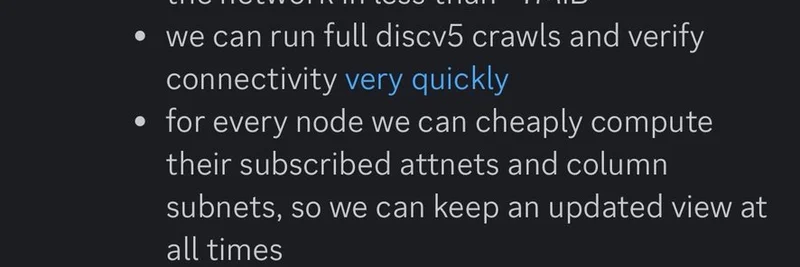Ethereum's peer-to-peer (P2P) networking is getting a serious upgrade, and if you're knee-deep in blockchain tech—or just love seeing memes pump faster on decentralized exchanges—this is the kind of innovation that keeps the ecosystem humming. Raúl (@raulvk), the P2P networking lead at the Ethereum Foundation, dropped some fire insights in a recent X thread, highlighting "tactical peering" as the next big leap for how Ethereum clients choose their connections. It's not just about speed; it's about making the network smarter, more resilient, and ready for scale.
If you're new to this, think of Ethereum's consensus layer (CL)—the part handling proofs and validator duties—as a massive digital town hall. Nodes (your validators or clients) need to chat efficiently to keep everything in sync. Random peer selection works fine for small crowds, but with thousands of nodes, it's like yelling in a packed stadium. Tactical peering flips the script: clients actively scout and prioritize peers based on real-time needs, like low latency for block propagation or targeting specific subnets for attestations.
Raúl's thread kicks off with the core idea, crediting Aarsh and Kasey at Prysm Labs for already prototyping this in their client. The attached image lays out the juicy details—let's break it down step by step.
The Full Network Picture in Your Pocket
First off, Raúl points out something mind-blowing: with around 13,000 peers in the CL network, you can store a complete map of everyone using just 300 bytes per ENR (Ethereum Node Record)—that's the node's digital ID card—plus 64 bytes for the Node ID and a smidge of metadata. Total? Less than 7MB. That's smaller than your average cat meme video.
Why does this matter? It means any client can hold an up-to-date "full view" of the network without guzzling RAM. No more partial snapshots leading to blind spots.
Lightning-Fast Crawls and Connectivity Checks
Next up: full discv5 crawls. Discv5 is Ethereum's discovery protocol—like a supercharged phonebook for finding nodes. Running a complete crawl verifies connectivity across the board in a flash. Pair that with cheap computations for each node's subscribed attnets (attestation subnets) and colum subnets—the groups handling specific duties—and you've got a dynamic, always-fresh topology.
In plain speak: your node knows exactly who's serving which slice of the network at all times. This keeps the attestation game tight, reducing delays in proving blocks.
Duty-Ready Targeting
As validators gear up for their shifts (duties), this intel lets them laser-focus on peers already dialed into the relevant subnets. No more shotgun connections—just precise handshakes with the right crowd. It's efficiency on steroids, cutting out the noise and boosting performance where it counts.
QUIC Tricks for Near-Zero Wait Times
Looking ahead, Raúl teases QUIC session resumption and 0-RTT (zero round-trip time) handshakes. QUIC is the modern transport protocol powering HTTP/3, and here it's Ethereum's ticket to skipping the usual connection chit-chat. Imagine reconnecting to a peer and firing off a message immediately—no awkward "hello" phase. That's game-changing for latency-sensitive ops like block gossiping.
Raúl's follow-ups amp up the excitement with experimental features:
- Quota Buckets: Slot peers into dedicated "buckets" for tasks like ultra-low-latency block relays or maximizing reach into the next attnet.
- Altruistic Slots: Reserve spots for newcomers, helping bootstrap and sync without hogging resources.
- RTT Tracking: Measure round-trip times as a core metric for smarter bucketing (shoutout to @soispoke for ideas).
- Proof of Validator Prioritization: Using prototypes from @asn_d6's crypto team to favor verified validators.
- Privacy Boosts: Oblivious routing tables to shield identities, plus token exchanges for quick QUIC resumes and secure reseeding on restarts.
As Raúl wraps it: "In a year, we will not recognize Eth networking I swear 🌟"
Why This Rocks for Blockchain Builders (and Meme Enthusiasts)
Tactical peering isn't abstract—it's the backbone for a snappier Ethereum. Faster peer discovery means quicker syncs for new nodes, lower latency for DeFi trades, and smoother sails for NFT drops or meme coin launches. In a world where every millisecond counts (hello, arbitrage bots), this could shave seconds off transaction finality, making the network more competitive against L2s or rivals.
Prysm's v6.1.2 already hints at these vibes, and with Ethereum Foundation backing, expect rollouts soon. If you're running a node or building dApps, keep an eye on Prysm's repo for updates.
Raúl's thread sparked chats on resilience—Chris Gilbert (@0xgilbert) flagged DoS risks from "lying" nodes, and Raúl countered with QoS-based evaluation over global scores. Solid discourse, keeping the upgrades robust.
Ethereum's evolving from a clunky relay to a precision machine. What's your take—will tactical peering be the quiet hero of the next bull run? Drop thoughts below, and stay tuned for more blockchain deep dives here at Meme Insider.
Follow us for the freshest on meme tokens, tech upgrades, and everything in between.



